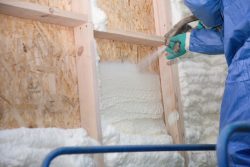Does Insulation Reduce Noise?
Insulation is a key component of any home, helping to regulate temperature and keep your living space comfortable. However, insulation can also have another benefit – reducing noise. In this blog post, we will explore how insulation can help reduce noise and enhance your home’s acoustic environment.
How Insulation Reduces Noise?
Insulation can reduce noise by absorbing sound waves. Sound waves are vibrations that travel through the air and are absorbed by dense materials. Insulation is designed to absorb these sound waves, which can help reduce the amount of noise that enters or leaves your home.
There are two types of noise that insulation can reduce: airborne noise, and impact noise. Airborne noise is sound that travels through the air, such as conversations or music. Impact noise is sound that’s created by impact or vibrations, such as footsteps or a slamming door.
By absorbing these sound waves, insulation can help reduce noise transmission between rooms or from outside. This can make your home a more peaceful and pleasant environment.
What Type of Insulation Works Best?
While all insulation can help reduce noise to some extent, there are certain types of insulation that are specifically designed for soundproofing. Two of the most common types of insulation used for soundproofing are fiberglass and cellulose.
Fiberglass insulation is made of fine glass fibers that are woven together to form a blanket-like material. This type of insulation is affordable and easy to install, making it a popular choice for soundproofing. It’s also effective at reducing airborne noise, making it ideal for rooms where music or conversation is often present.
Cellulose insulation is made of recycled paper or wood fibers. It’s a more eco-friendly option than fiberglass, and it’s also effective at reducing airborne noise. It’s denser than fiberglass, making it an excellent choice for reducing impact noise like footsteps or slamming doors.
How to Install Insulation for Soundproofing?
To install insulation for soundproofing, you’ll need to take a few additional steps beyond standard installation. The first step is to determine which type of insulation is best for your needs. Once you’ve chosen the right type of insulation, it’s time to install it.
When installing insulation for soundproofing, it’s important to fill the entire cavity of the wall or ceiling. Any gaps or spaces can allow sound waves to travel through, reducing the effectiveness of the insulation. It’s also important to seal any air leaks, which can also allow sound waves to pass through.
Another key factor to consider when installing insulation for soundproofing is the STC rating. The STC, or Sound Transmission Class, is a rating system that measures how well a material can block sound. The higher the STC rating, the more effective the material is at blocking sound. When choosing insulation, look for products with a higher STC rating, which will be the most effective at reducing noise.
Conclusion
Insulation can be an effective way to reduce noise and create a more comfortable, peaceful living environment. By absorbing sound waves and preventing them from passing through walls and ceilings, insulation can reduce both airborne and impact noises. When selecting insulation for soundproofing, it’s important to choose the right type, fill all gaps, and seal air leaks to maximize its effectiveness.
If you’re concerned about noise in your home, contact one of our professional insulation contractors to discuss insulation options that can help reduce noise and create a more comfortable living space. By working with an experienced professional, you can ensure that your home is properly insulated and designed to provide the best possible acoustic environment.


